The Role of Ocean Penetrative Solar Radiation in the Evolution of Mediterranean Storm Daniel
Abstract
1. Introduction
2. Materials and Methods
2.1. Coupled Model Description
2.2. Penetrative Solar Radiation in the Ocean Model
2.3. Datasets
2.4. Case Study and Model Experiments
- Control run (CTL): This simulation employed a fixed Jerlov-type attenuation, uniform in both time and space. The attenuation parameters (R, ξ0, ξ1) in Equation (1) were set to (0.58, 0.35, 23), representing Type I water in Jerlov’s [44] classification, which corresponds to oligotrophic conditions.
- Chlorophyll-based run (RGB): In this simulation, solar radiation penetration was calculated using the RGB formulation (Equation (2)), which varies as a function of surface Chl-a concentration. The Chl-a data were obtained from the daily Copernicus GlobColour satellite-based dataset.
3. Results
3.1. Storm Track and Intensity Evolution
3.2. Shortwave Radiation Penetration
3.3. Sea Surface Temperature Sensitivity
3.4. Upper Ocean and Surface Waves Response
3.5. Impact on Air–Sea Fluxes and Precipitation
4. Summary and Discussion
Supplementary Materials
Author Contributions
Funding
Data Availability Statement
Acknowledgments
Conflicts of Interest
Appendix A
| Component | Physics Parameter | Configuration |
|---|---|---|
| Atmosphere (WRF) | Microphysics | Thompson (mp_physics = 8) |
| Cumulus | Tiedke (cu_physics = 6) | |
| Longwave radiation | RRTMG (ra_lw_physics = 4) | |
| Shortwave radiation | RRTMG (ra_sw_physics = 4) | |
| Planetary boundary layer | YSU (bl_pbl_physics = 1) | |
| Land surface | Unified Noah (sf_surface_physics = 2) | |
| Surface layer | Revised MM5 (sf_sfclay_physics = 1) | |
| Ocean (NEMO) | Vertical mixing | GLS scheme |
| Horiz. viscosity & diffusivity | Bi-Laplacian | |
| Free-surface formulation | Split-explicit free surface scheme | |
| Tracer advection | QUICKEST scheme | |
| Momentum advection | Vector form (energy & enstrophy cons. scheme) | |
| Lateral friction | Partial slip; Strong slip in Gibraltar & Black Sea Straits | |
| Bottom friction | Log-layer | |
| Runoff | 11 rivers from GRDC database | |
| Tidal forcing | 11 cons. from TPXO7.2 tidal model | |
| Surface waves (WW3) | GSE alleviation method | Spatial averaging (PR3) |
| Propagation scheme | Third-order scheme (UQ) | |
| Wind-wave source term | ST4 package, TEST405 params. | |
| Nonlinear wave–wave interactions | Discrete Interaction Approximation (NL1) | |
| Linear input | Cavaleri and Malanotte-Rizzoli with filter (LN1) | |
| Bottom friction | JONSWAP formulation (BT1) | |
| Depth-induced breaking | Battjes-Janssen formulation (DB1) | |
| Energy reflection | Shoreline reflections (REF1) |
References
- Emanuel, K. Genesis and maintenance of “Mediterranean hurricanes”. Adv. Geosci. 2005, 2, 217–220. [Google Scholar] [CrossRef]
- Lionello, P.; Cavaleri, L.; Nissen, K.M.; Pino, C.; Raicich, F.; Ulbrich, U. Severe marine storms in the Northern Adriatic: Characteristics and trends. Phys. Chem. Earth 2012, 40–41, 93–105. [Google Scholar] [CrossRef]
- Lionello, P.; Conte, D.; Reale, M. The effect of cyclones crossing the Mediterranean region on sea level anomalies on the Mediterranean Sea coast. Nat. Hazards Earth Syst. Sci. 2019, 19, 1541–1564. [Google Scholar] [CrossRef]
- Patlakas, P.; Stathopoulos, C.; Tsalis, C.; Kallos, G. Wind and wave extremes associated with tropical-like cyclones in the Mediterranean basin. Int. J. Climatol. 2021, 41 (Suppl. S1), E1623–E1644. [Google Scholar] [CrossRef]
- Flaounas, E.; Davolio, S.; Raveh-Rubin, S.; Pantillon, F.; Miglietta, M.M.; Gaertner, M.A.; Hatzaki, M.; Homar, V.; Khodayar, S.; Korres, G.; et al. Mediterranean cyclones: Current knowledge and open questions on dynamics, prediction, climatology and impacts. Weather Clim. Dynam. 2022, 3, 173–208. [Google Scholar] [CrossRef]
- Ferrarin, C.; Pantillon, F.; Davolio, S.; Bajo, M.; Miglietta, M.M.; Avolio, E.; Carrió, D.S.; Pytharoulis, I.; Sanchez, C.; Patlakas, P.; et al. Assessing the coastal hazard of Medicane Ianos through ensemble modelling. Nat. Hazards Earth Syst. Sci. 2023, 23, 2273–2287. [Google Scholar] [CrossRef]
- Portal, A.; Raveh-Rubin, S.; Catto, J.L.; Givon, Y.; Martius, O. Linking compound weather extremes to Mediterranean cyclones, fronts, and airstreams. Weather Clim. Dynam. 2024, 5, 1043–1060. [Google Scholar] [CrossRef]
- Rousseau-Rizzi, R.; Raveh-Rubin, S.; Catto, J.L.; Portal, A.; Givon, Y.; Martius, O. A storm-relative climatology of compound hazards in Mediterranean cyclones. Weather Clim. Dynam. 2024, 5, 1079–1101. [Google Scholar] [CrossRef]
- Khodayar, S.; Kushta, J.; Catto, J.L.; Dafis, S.; Davolio, S.; Ferrarin, C.; Flaounas, E.; Groenemeijer, P.; Hatzaki, M.; Hochman, A.; et al. Mediterranean cyclones in a changing climate: A review on their socio-economic impacts. Rev. Geophys. 2025, 63, e2024RG000853. [Google Scholar] [CrossRef]
- Pytharoulis, I. Analysis of a Mediterranean tropical-like cyclone and its sensitivity to the sea surface temperatures. Atmos. Res. 2018, 208, 167–179. [Google Scholar] [CrossRef]
- Stathopoulos, C.; Patlakas, P.; Tsalis, C.; Kallos, G. The Role of Sea Surface Temperature Forcing in the Life-Cycle of Mediterranean Cyclones. Remote Sens. 2020, 12, 825. [Google Scholar] [CrossRef]
- Varlas, G.; Pytharoulis, I.; Steeneveld, G.-J.; Katsafados, P.; Papadopoulos, A. Investigating the impact of sea surface temperature on the development of the Mediterranean tropical-like cyclone “Ianos” in 2020. Atmos. Res. 2023, 291, 106827. [Google Scholar] [CrossRef]
- Argüeso, D.; Marcos, M.; Amores, A. Storm Daniel fueled by anomalously high sea surface temperatures in the Mediterranean. NPJ Clim. Atmos. Sci. 2024, 7, 307. [Google Scholar] [CrossRef]
- Avolio, E.; Fanelli, C.; Pisano, A.; Miglietta, M.M. Unveiling the relationship between Mediterranean tropical-like cyclones and rising Sea Surface Temperature. Geophys. Res. Lett. 2024, 51, e2024GL109921. [Google Scholar] [CrossRef]
- Karagiorgos, J.; Vervatis, V.; Samos, I.; Flocas, H.; Sofianos, S. Ocean-wave-atmosphere coupling effect in Medicane forecasting. Atmos. Res. 2024, 304, 107418. [Google Scholar] [CrossRef]
- Sánchez, C.; Gray, S.; Volonté, A.; Pantillon, F.; Berthou, S.; Davolio, S. The impact of preceding convection on the development of Medicane Ianos and the sensitivity to sea surface temperature. Weather Clim. Dynam. 2024, 5, 1429–1455. [Google Scholar] [CrossRef]
- Patlakas, P.; Chaniotis, I.; Hatzaki, M.; Kouroutzoglou, J.; Flocas, H.A. The eastern Mediterranean extreme snowfall of January 2022: Synoptic analysis and impact of sea-surface temperature. Weather 2024, 79, 25–33. [Google Scholar] [CrossRef]
- Morel, A.; Antoine, D. Heating rate within the upper ocean in relation to its bio–optical state. J. Phys. Oceanogr. 1994, 24, 1652–1665. [Google Scholar] [CrossRef]
- Paulson, C.A.; Simpson, J.J. Irradiance measurements in the upper ocean. J. Phys. Oceanogr. 1977, 7, 952–956. [Google Scholar] [CrossRef]
- Karagiorgos, J.; Vervatis, V.; Sofianos, S. Ocean chlorophyll feedback in a coupled ocean-atmosphere model for the Mediterranean and Black Seas. J. Geophys. Res. Ocean. 2025, 130, e2024JC021985. [Google Scholar] [CrossRef]
- Metheniti, V.; Vervatis, V.; Kampanis, N.; Sofianos, S. Turbidity effects on the Aegean sea surface properties using numerical simulations. Ocean Dyn. 2024, 75, 4. [Google Scholar] [CrossRef]
- Zhang, Y.; Sevault, F.; Pennel, R.; Baklouti, M. Analysis of the impact of vertical variation and temporal frequency of the chlorophyll forcing field on modelled temperature in the Mediterranean Sea and potential implications for regional climate projections. Ocean Model. 2025, 194, 102490. [Google Scholar] [CrossRef]
- Gnanadesikan, A.; Emanuel, K.; Vecchi, G.A.; Anderson, W.G.; Hallberg, R. How ocean color can steer Pacific tropical cyclones. Geophys. Res. Lett. 2010, 37, L18802. [Google Scholar] [CrossRef]
- Newinger, C.; Toumi, R. Potential impact of the colored Amazon and Orinoco plume on tropical cyclone intensity. J. Geophys. Res. Ocean. 2015, 120, 1296–1317. [Google Scholar] [CrossRef]
- Liu, Y.; He, R.; Lee, Z. Effects of ocean optical properties and solar attenuation on the northwestern Atlantic Ocean heat content and hurricane intensity. Geophys. Res. Lett. 2021, 48, e2021GL094171. [Google Scholar] [CrossRef]
- Hewson, T.; Ashoor, A.; Boussetta, S.; Emanuel, K.; Lagouvardos, K.; Lavers, D.; Magnusson, L.; Pillosu, F.; Zsoter, E. Medicane Daniel: An extraordinary cyclone with devastating impacts. In ECMWF Newsletter; European Centre for Medium-Range Weather Forecasts: Reading, UK, 2024; pp. 33–47. [Google Scholar] [CrossRef]
- Flaounas, E.; Dafis, S.; Davolio, S.; Faranda, D.; Ferrarin, C.; Hartmuth, K.; Hochman, A.; Koutroulis, A.; Khodayar, S.; Miglietta, M.M.; et al. Dynamics, predictability, impacts, and climate change considerations of the catastrophic Mediterranean Storm Daniel (2023). EGUsphere 2024. [Google Scholar] [CrossRef]
- Gurvan, M.; Bourdallé-Badie, R.; Bricaud, C.; Bruciaferri, D.; Calvert, D.; Chanut, J.; Clementi, E.; Coward, A.; Delrosso, D.; Ethé, C.; et al. Nemo ocean engine. Zenodo 2022. [Google Scholar] [CrossRef]
- Skamarock, W.C.; Klemp, J.B.; Dudhia, J.; Gill, D.O.; Liu, Z.; Berner, J.; Wang, W.; Powers, J.G.; Duda, M.G.; Barker, D.M.; et al. A Description of the Advanced Research WRF Model Version 4.3; No. NCAR/TN-556+STR; NCAR: Boulder, CO, USA, 2021. [Google Scholar] [CrossRef]
- The WAVEWATCH III® Development Group. User Manual and System Documentation of WAVEWATCH III® Version 6.07; Tech. Note 333; NOAA/NWS/NCEP/MMAB: College Park, MD, USA, 2019; 465p+Appendices. [Google Scholar]
- Craig, A.; Valcke, S.; Coquart, L. Development and performance of a new version of the OASIS coupler, OASIS3-MCT_3.0. Geosci. Model Dev. 2017, 10, 3297–3308. [Google Scholar] [CrossRef]
- Hersbach, H.; Bell, B.; Berrisford, P.; Hirahara, S.; Horányi, A.; Muñoz-Sabater, J.; Nicolas, J.; Peubey, C.; Radu, R.; Schepers, D.; et al. The ERA5 global reanalysis. Q. J. R. Meteorol. Soc. 2020, 146, 1999–2049. [Google Scholar] [CrossRef]
- Lellouche, J.-M.; Greiner, E.; Bourdallé-Badie, R.; Garric, G.; Melet, A.; Drévillon, M.; Clément, B.; Mathieu, H.; Olivier, L.G.; Charly, R.; et al. The Copernicus global 1/12° oceanic and sea ice GLORYS12 reanalysis. Front. Earth Sci. 2021, 9, 698876. [Google Scholar] [CrossRef]
- Morel, A. Optical modeling of the upper ocean in relation to its biogenous matter content (case I waters). J. Geophys. Res. 1988, 93, 10749–10768. [Google Scholar] [CrossRef]
- Lengaigne, M.; Menkes, C.; Aumont, O.; Gorgues, T.; Bopp, L.; André, J.-M.; Madec, G. Influence of the oceanic biology on the tropical Pacific climate in a coupled general circulation model. Clim. Dyn. 2007, 28, 503–516. [Google Scholar] [CrossRef]
- Good, S.; Fiedler, E.; Mao, C.; Martin, M.J.; Maycock, A.; Reid, R.; Roberts-Jones, J.; Searle, T.; Waters, J.; While, J.; et al. The current configuration of the OSTIA system for operational production of foundation sea surface temperature and ice concentration analyses. Remote Sens. 2020, 12, 720. [Google Scholar] [CrossRef]
- Buongiorno Nardelli, B.; Tronconi, C.; Pisano, A.; Santoleri, R. High and Ultra-High resolution processing of satellite Sea Surface Temperature data over Southern European Seas in the framework of MyOcean project. Remote Sens. Environ. 2013, 129, 1–16. [Google Scholar] [CrossRef]
- Huffman, G.J.; Stocker, E.F.; Bolvin, D.T.; Nelkin, E.J.; Tan, J. GPM IMERG Final Precipitation L3 Half Hourly 0.1 Degree × 0.1 Degree V07; Goddard Earth Sciences Data and Information Services Center (GES DISC): Greenbelt, MD, USA, 2023. [Google Scholar] [CrossRef]
- Natural Colour RGB—MSG—0 Degree. Available online: https://data.eumetsat.int/product/EO:EUM:DAT:MSG:NCL# (accessed on 26 May 2025).
- Garnesson, P.; Mangin, A.; Fanton d’Andon, O.; Demaria, J.; Bretagnon, M. The CMEMS GlobColour chlorophyll a product based on satellite observation: Multi-sensor merging and flagging strategies. Ocean Sci. 2019, 15, 819–830. [Google Scholar] [CrossRef]
- He, K.; Yang, Q.; Shen, X.; Dimitriou, E.; Mentzafou, A.; Papadaki, C.; Stoumboudi, M.; Anagnostou, E.N. Brief communication: Storm Daniel flood impact in Greece in 2023: Mapping crop and livestock exposure from synthetic-aperture radar (SAR). Nat. Hazards Earth Syst. Sci. 2024, 24, 2375–2382. [Google Scholar] [CrossRef]
- GreekReporter: The EU Offers Greece € 2.25 Billion to Recover from Deadly Floods. Available online: https://greekreporter.com/2023/09/13/greece-2-25-billion-eu-recover-floods/ (accessed on 21 July 2025).
- AP News: Searchers Race to Recover Bodies in Libyan City Where 5,100 Died in Flooding After 2 Dams Collapsed. Available online: https://apnews.com/article/libya-floods-derna-storm-daniel-39081eb32e4fd426119f4b486c9c2ade#:~:text=At%20least%2030%2C000%20people%20in,International%20Organization%20for%20Migration%20said.&text=The%20storm%20hit%20other%20areas,of%20Bayda%2C%20Susa%20and%20Marj (accessed on 21 July 2025).
- Jerlov, N. Index. In Marine Optics; Elsevier: Amsterdam, The Netherlands, 1976; Volume 14, pp. 227–231. [Google Scholar] [CrossRef]
- Manizza, M.; Le Quéré, C.; Watson, A.J.; Buitenhuis, E.T. Bio-optical feedbacks among phytoplankton, upper ocean physics and sea-ice in a global model. Geophys. Res. Lett. 2005, 32, L05603. [Google Scholar] [CrossRef]
- Sweeney, C.; Gnanadesikan, A.; Griffies, S.M.; Harrison, M.J.; Rosati, A.J.; Samuels, B.L. Impacts of Shortwave Penetration Depth on Large-Scale Ocean Circulation and Heat Transport. J. Phys. Oceanogr. 2005, 35, 1103–1119. [Google Scholar] [CrossRef]
- Ma, Z.; Fei, J.; Lin, Y.; Huang, X. Modulation of clouds and rainfall by tropical cyclone’s cold wakes. Geophys. Res. Lett. 2020, 47, e2020GL088873. [Google Scholar] [CrossRef]
- Karnauskas, K.B.; Zhang, L.; Emanuel, K.A. The feedback of cold wakes on tropical cyclones. Geophys. Res. Lett. 2021, 48, e2020GL091676. [Google Scholar] [CrossRef]
- Pasquero, C.; Desbiolles, F.; Meroni, A.N. Air-sea interactions in the cold wakes of tropical cyclones. Geophys. Res. Lett. 2021, 48, e2020GL091185. [Google Scholar] [CrossRef]
- Zhang, J.; Lin, Y.; Ma, Z. Footprint of tropical cyclone cold wakes on top-of-atmosphere radiation. Geophys. Res. Lett. 2021, 48, e2021GL094705. [Google Scholar] [CrossRef]
- Ma, Z.; Lin, Y.; Fei, J.; Zheng, Y.; Chu, W.; Ye, H. Strengthening cold wakes lead to decreasing trend of tropical cyclone rainfall rates relative to background environmental rainfall rates. NPJ Clim. Atmos. Sci. 2023, 6, 131. [Google Scholar] [CrossRef]
- Di Muzio, E.; Riemer, M.; Fink, A.H.; Maier-Gerber, M. Assessing the predictability of Medicanes in ECMWF ensemble forecasts using an object-based approach. Q. J. R. Meteorol. Soc. 2019, 145, 1202–1217. [Google Scholar] [CrossRef]
- Pantillon, F.; Davolio, S.; Avolio, E.; Calvo-Sancho, C.; Carrió, D.S.; Dafis, S.; Gentile, E.S.; Gonzalez-Aleman, J.J.; Gray, S.; Miglietta, M.M.; et al. The crucial representation of deep convection for the cyclogenesis of Medicane Ianos. Weather Clim. Dynam. 2024, 5, 1187–1205. [Google Scholar] [CrossRef]
- Gnanadesikan, A.; Kim, G.E.; Pradal, M.A.S. Impact of colored dissolved materials on the annual cycle of sea surface temperature: Potential implications for extreme ocean temperatures. Geophys. Res. Lett. 2019, 46, 861–869. [Google Scholar] [CrossRef]
- de Toma, V.; Ciani, D.; Hesham Essa, Y.; Yang, C.; Artale, V.; Pisano, A.; Cavaliere, D.; Santoleri, R.; Storto, A. Skin sea surface temperature schemes in coupled ocean–atmosphere modelling: The impact of chlorophyll-interactive e-folding depth. Geosci. Model Dev. 2024, 17, 5145–5165. [Google Scholar] [CrossRef]
- Witte, C.R.; Subramaniam, A.; Zappa, C.J. An improved bio-physical parameterization for ocean radiant heating in conditions of near-surface stratification. J. Geophys. Res. Ocean. 2024, 129, e2024JC021049. [Google Scholar] [CrossRef] [PubMed]
- Menkes, C.E.; Lengaigne, M.; Lévy, M.; Ethé, C.; Bopp, L.; Aumont, O.; Vincent, E.; Vialard, J.; Jullien, S. Global impact of tropical cyclones on primary production. Glob. Biogeochem. Cycles 2016, 30, 767–786. [Google Scholar] [CrossRef]
- Zang, Z.; Xue, Z.G.; Xu, K.; Bentley, S.J.; Chen, Q.; D’Sa, E.J.; Zhang, L.; Ou, Y. The role of sediment-induced light attenuation on primary production during Hurricane Gustav (2008). Biogeosciences 2020, 17, 5043–5055. [Google Scholar] [CrossRef]
- Da, N.D.; Foltz, G.R.; Balaguru, K. Observed global increases in tropical cyclone-induced ocean cooling and primary production. Geophys. Res. Lett. 2021, 48, e2021GL092574. [Google Scholar] [CrossRef]
- CMEMS. SST_GLO_SST_L4_NRT_OBSERVATIONS_010_001: Global Ocean OSTIA Sea Surface Temperature and Sea Ice Analysis; [Dataset]; E.U. Copernicus Marine Service Information (CMEMS), Marine Data Store (MDS): Toulouse, France, 2025. [Google Scholar] [CrossRef]
- CMEMS. SST_MED_SST_L4_NRT_OBSERVATIONS_010_004: Mediterranean Sea High Resolution and Ultra High Resolution Sea Surface Temperature Analysis; [Dataset]; E.U. Copernicus Marine Service Information (CMEMS), Marine Data Store (MDS): Toulouse, France, 2025. [Google Scholar] [CrossRef]
- CMEMS. OCEANCOLOUR_GLO_BGC_L4_MY_009_104: Global Ocean Colour (Copernicus-GlobColour), Bio-Geo-Chemical, L4 (Monthly and Interpolated) from Satellite Observations (1997–Ongoing); [Dataset]; E.U. Copernicus Marine Service Information (CMEMS), Marine Data Store (MDS): Toulouse, France, 2025. [Google Scholar] [CrossRef]
- CMEMS. GLOBAL_MULTIYEAR_PHY_001_030: Global Ocean Physics Reanalysis; [Dataset]; E.U. Copernicus Marine Service Information (CMEMS), Marine Data Store (MDS): Toulouse, France, 2025. [Google Scholar] [CrossRef]
- C3S. ERA5 Hourly Data on Single Levels from 1940 to Present; [Dataset]; Copernicus Climate Change Service (C3S) Climate Data Store (CDS): Reading, UK, 2023. [Google Scholar] [CrossRef]

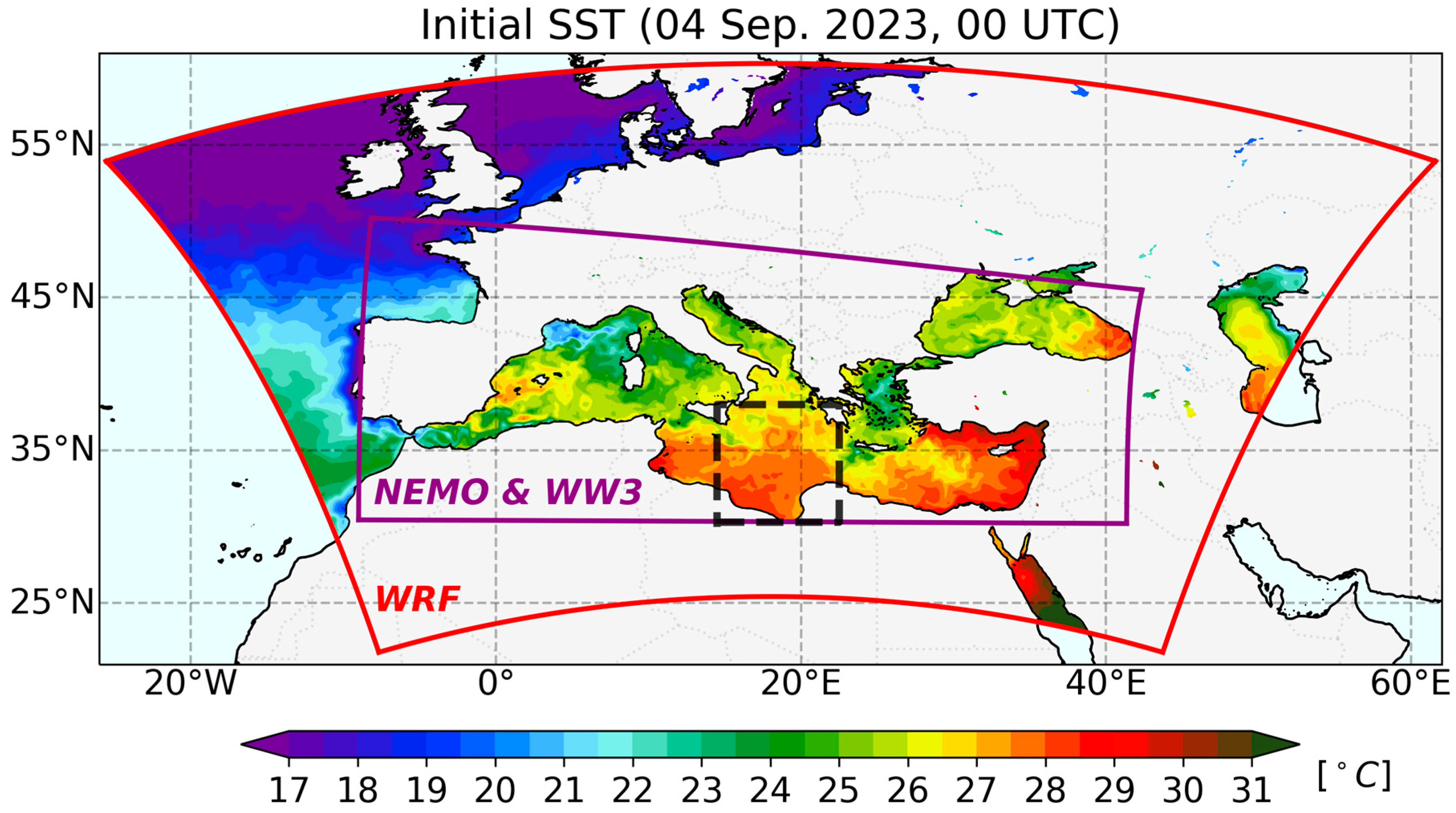


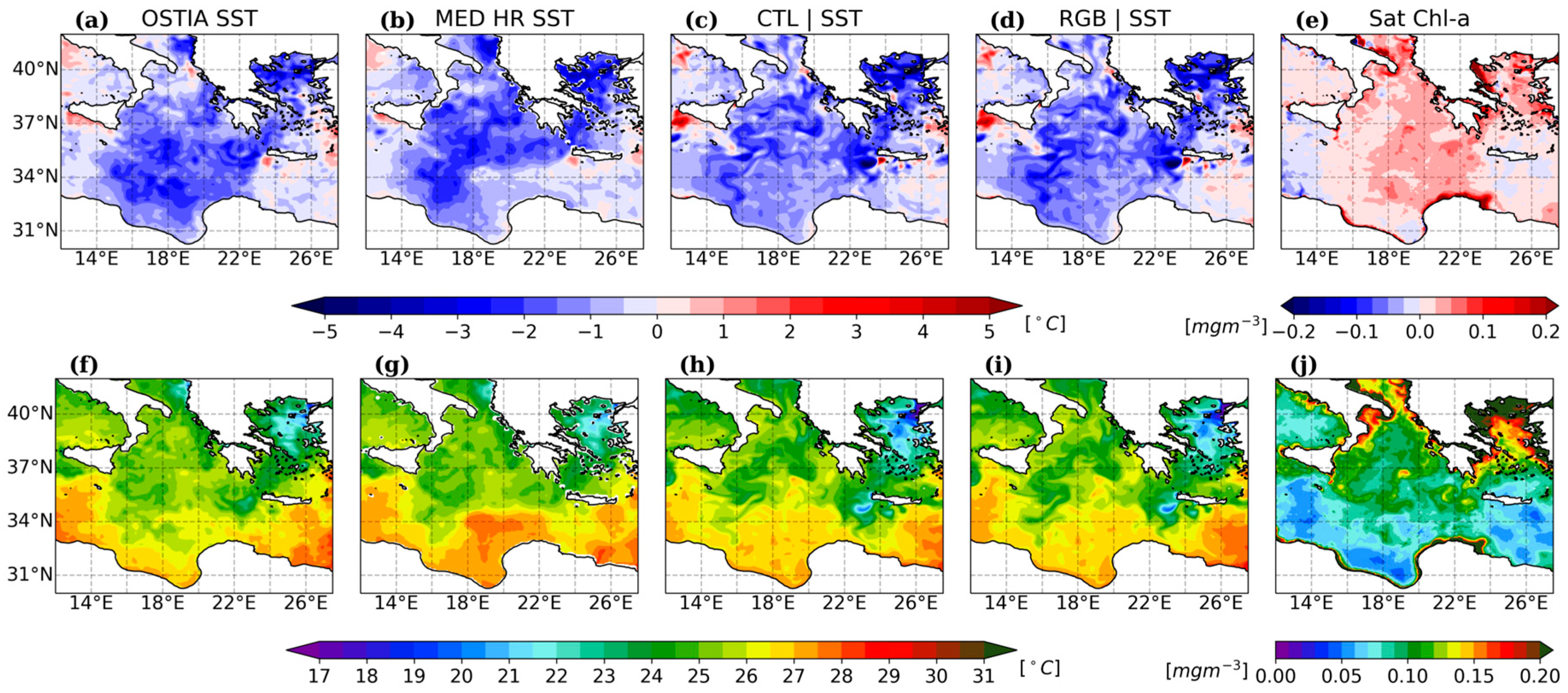
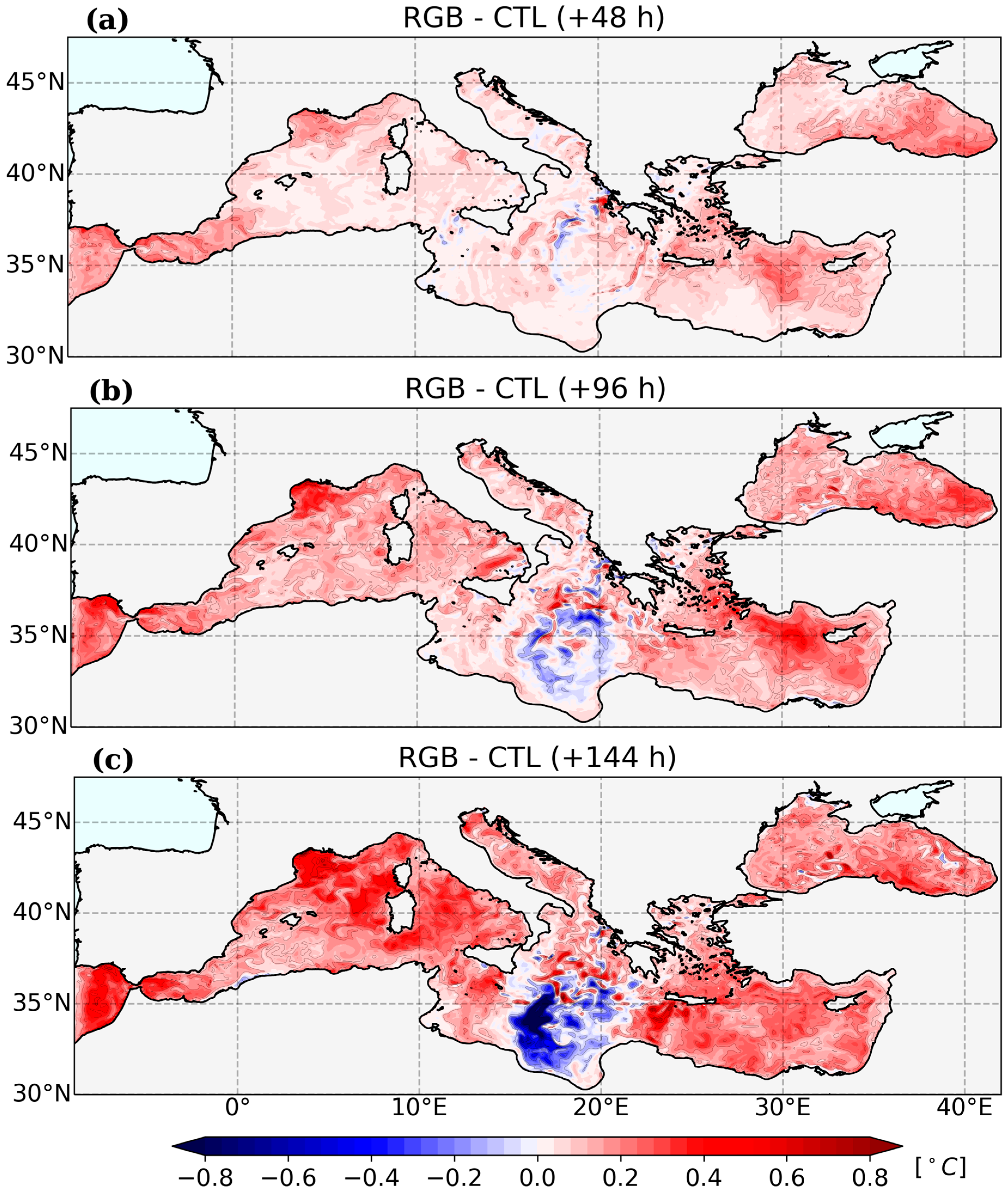
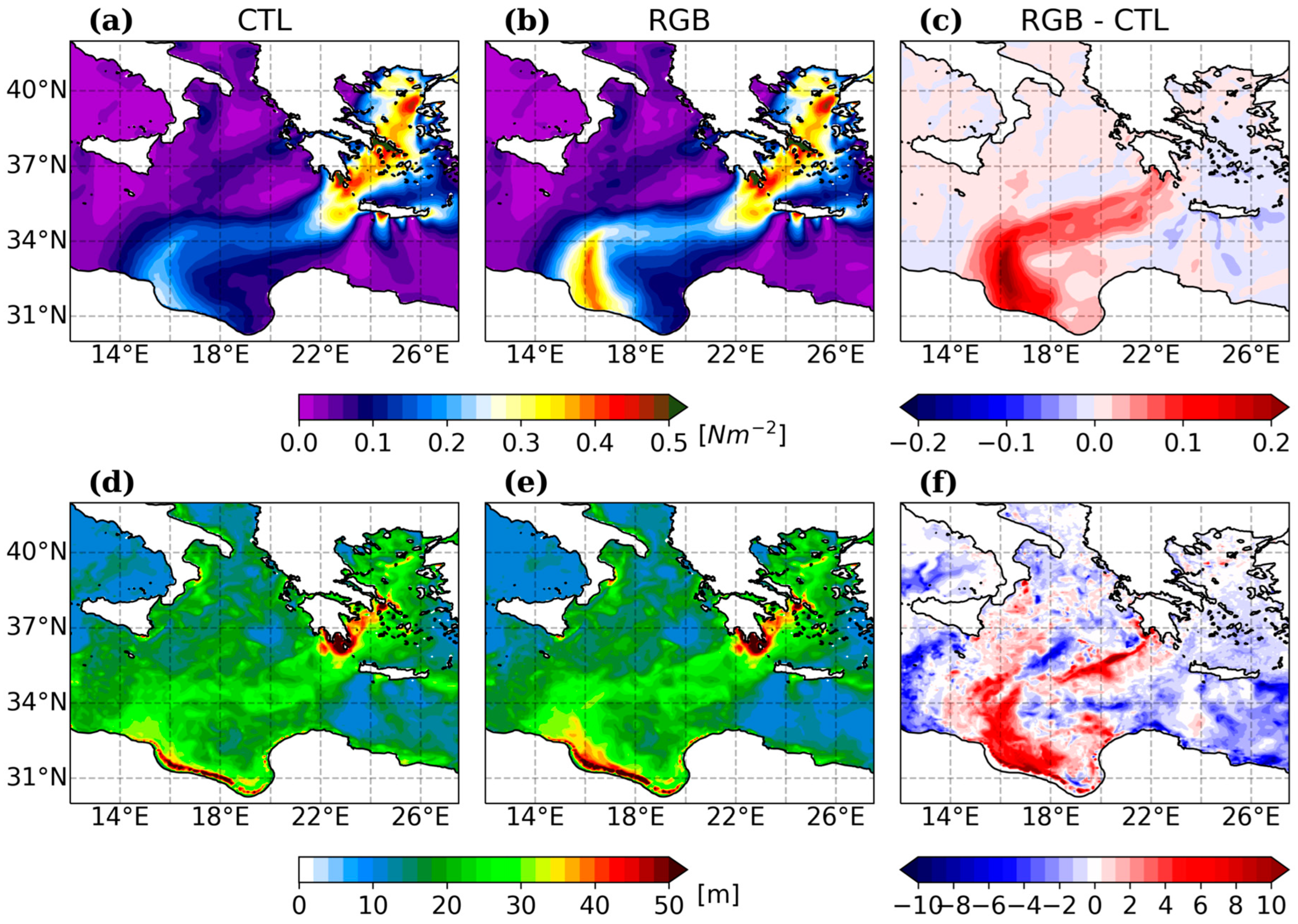
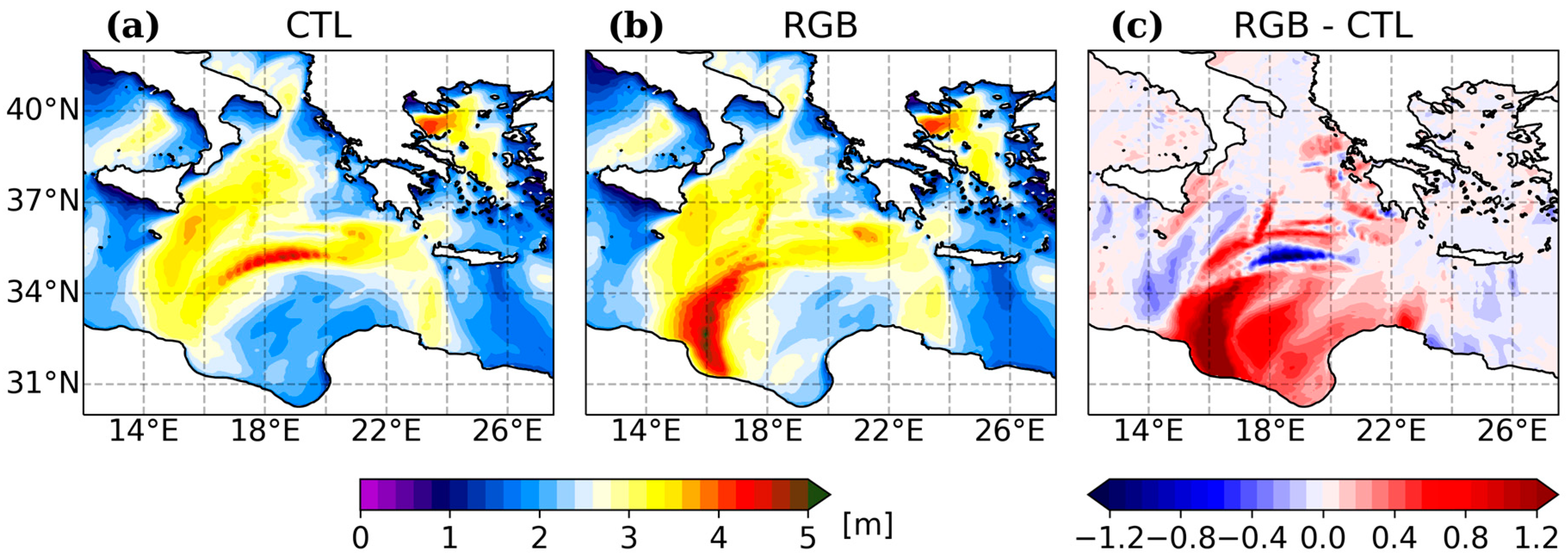
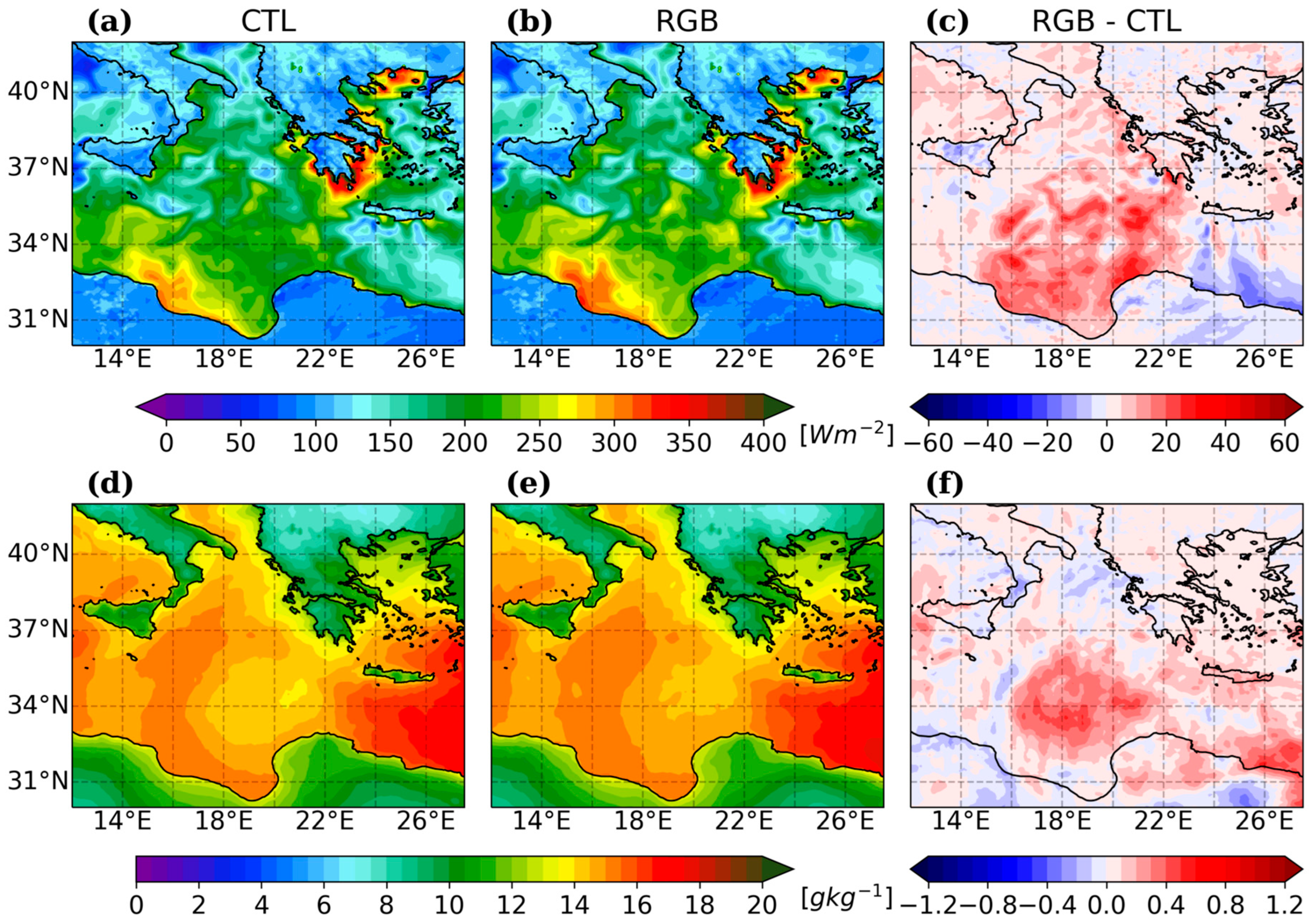

Disclaimer/Publisher’s Note: The statements, opinions and data contained in all publications are solely those of the individual author(s) and contributor(s) and not of MDPI and/or the editor(s). MDPI and/or the editor(s) disclaim responsibility for any injury to people or property resulting from any ideas, methods, instructions or products referred to in the content. |
© 2025 by the authors. Licensee MDPI, Basel, Switzerland. This article is an open access article distributed under the terms and conditions of the Creative Commons Attribution (CC BY) license (https://creativecommons.org/licenses/by/4.0/).
Share and Cite
Karagiorgos, J.; Patlakas, P.; Vervatis, V.; Sofianos, S. The Role of Ocean Penetrative Solar Radiation in the Evolution of Mediterranean Storm Daniel. Remote Sens. 2025, 17, 2684. https://doi.org/10.3390/rs17152684
Karagiorgos J, Patlakas P, Vervatis V, Sofianos S. The Role of Ocean Penetrative Solar Radiation in the Evolution of Mediterranean Storm Daniel. Remote Sensing. 2025; 17(15):2684. https://doi.org/10.3390/rs17152684
Chicago/Turabian StyleKaragiorgos, John, Platon Patlakas, Vassilios Vervatis, and Sarantis Sofianos. 2025. "The Role of Ocean Penetrative Solar Radiation in the Evolution of Mediterranean Storm Daniel" Remote Sensing 17, no. 15: 2684. https://doi.org/10.3390/rs17152684
APA StyleKaragiorgos, J., Patlakas, P., Vervatis, V., & Sofianos, S. (2025). The Role of Ocean Penetrative Solar Radiation in the Evolution of Mediterranean Storm Daniel. Remote Sensing, 17(15), 2684. https://doi.org/10.3390/rs17152684









